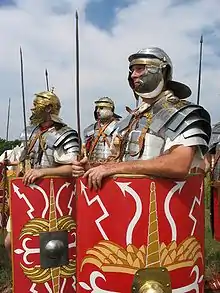
The New Testament uses a number of military metaphors in discussing Christianity, especially in the Pauline epistles.
In Philippians 2:25[1] and Philemon 1:2,[2] Paul describes fellow Christians as "fellow soldiers" (in Greek, συστρατιώτῃ, sustratiōtē).[3] The image of a soldier is also used in 2 Timothy 2:3–4[4] as a metaphor for courage, loyalty and dedication;[5] this is followed by the metaphor of an athlete, emphasising hard work. In 1 Corinthians 9:7,[6] this image is used in a discussion of church workers receiving payment, with a metaphorical reference to a soldier's rations and expenses.[7]
Ephesians 6:10–18[8] discusses faith, righteousness, and other elements of Christianity as the armour of God, and this imagery is replicated by John Bunyan in The Pilgrim's Progress,[9] and by many other Christian writers.
Related imagery appears in hymns such as "Soldiers of Christ, Arise" and "Onward, Christian Soldiers".[10]
See also
References
- ↑ Philippians 2:25, NIV (BibleGateway).
- ↑ Philemon 1:2, NIV (BibleGateway).
- ↑ Peter Thomas O'Brien, The Epistle to the Philippians: A commentary on the Greek text, Eerdmans, 1991, ISBN 0-85364-531-0, pp. 330–331.
- ↑ 2 Timothy 2:3–4, NIV (BibleGateway): "Endure hardship with us like a good soldier of Christ Jesus. No one serving as a soldier gets involved in civilian affairs—he wants to please his commanding officer."
- ↑ John Norman Davidson Kelly, A Commentary on the Pastoral Epistles: I Timothy, II Timothy, Titus, Part 1, Continuum International Publishing Group, 1963, ISBN 0-7136-1366-1, p. 175.
- ↑ 1 Corinthians 9:7, NIV (BibleGateway): "Who serves as a soldier at his own expense?"
- ↑ Anthony C. Thiselton, The First Epistle to the Corinthians: A Commentary on the Greek text, Eerdmans, 2000, ISBN 0-85364-559-0, pp. 683–684.
- ↑ Ephesians 6:10–18, NIV (BibleGateway).
- ↑ Kathleen M. Swaim, Pilgrim's Progress, Puritan Progress: Discourses and Contexts, University of Illinois Press, 1993, ISBN 0-252-01894-X, p. 14.
- ↑ Alison G. Sulloway, Gerard Manley Hopkins and the Victorian temper, Routledge, 1972, ISBN 0-7100-7354-2, p. 220.